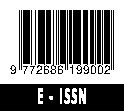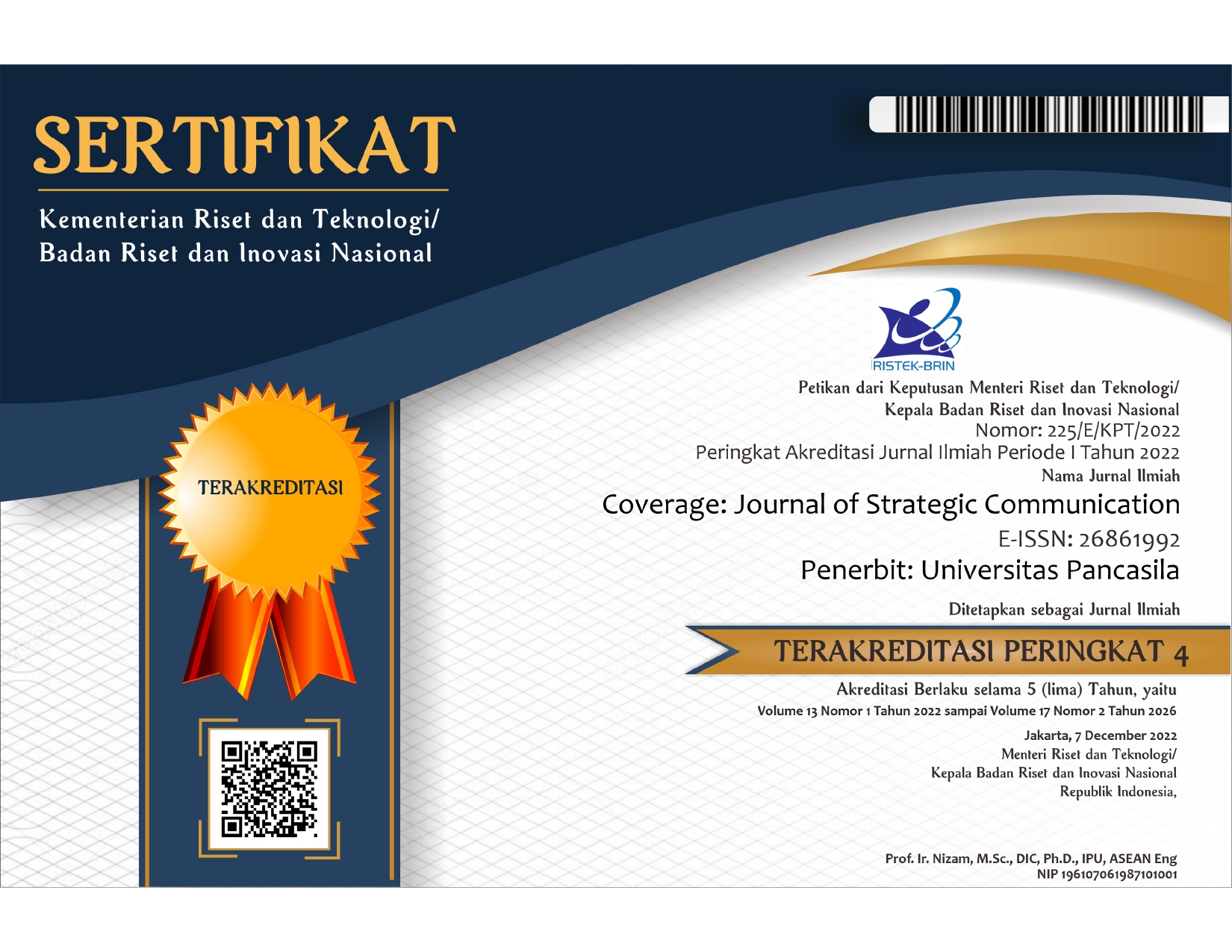Strategic Communication dalam Perspektif Ilmu Komunikasi
DOI:
https://doi.org/10.35814/coverage.v11i2.2028Keywords:
actor, action, negotiation, meaning and kommunicationAbstract
Strategic communication is a new study and beginning to develop and it is concern to many parties. However, many writings in international journals have not been identified as including communication concepts and theories. This article attempts to explain strategic communication from the perspective of communication science. The method used in this research is literature review, considering that many strategic communication thinkers have initiated their writings using literature reviews. The result, from the four definitions, found that strategic communication is built on actors, then action, interaction and negotiation, and the last is meaning. Actors in strategic communication are not only single actors, but multiple actors. With multiple actors, strategic communication will be more important and relevant. Whereas action, interaction and negotiation, in strategic communication, it is not only action, but interaction and negotiation are the discussion. Finally, meaning in strategic communication is a process from multiple actors, where they simultaneously carry out actions, interactions and negotiations.
References
Argenti, P.A., Howell, R.A., & Beck, K.A. (2005). The Strategic Communication Imperative. MIT Sloan Management Review, 46(3), 82-89.
Aggerholm, H. K., & Asmuß, B. (2016). A practice perspective on strategic communication. The discursive legitimization of managerial decisions. Journal of Communication Management, 20(3), 195–214.
Aggerholm, H. K., & Thomsen, C. (2016). Legitimation as a particular mode of strategic communication in the public sector. International Journal of Strategic Communication, 10(3), 195–206.
Bolderston, A. (2008). Writing an Effective Literature Review. Journal of Medical Imaging and Radiation Sciences, 39, 86-92.
Cherniak, A. (2018) Understanding of Meaning as a Communication Problem, Advances in Social Science, Education and Humanities Research, Vol. 233.
Cooren, F. (2006). Arguments for the in-depth study of organizational interactions: A rejoinder to McPhee, Myers, and Trethewey. Management Communication Quarterly, 19, 327–340.
Denney, A.S., & Tewksbury, R.T. (2012). How to Write a Literature Review, Journal of Criminal Justice Education, DOI:10.1080/10511253.2012.730617
Dervin, B. (1991). “Information as Nonsense; Information as Sense: The Communication Technology Connection.” Dalam H. Bouwman, P. Nelissen, & M. Vooijs (Eds.), Between Offer and Supply. Amsterdam, The Netherlands: Cramwinckel, 44-59.
Estaswara, H., Halim, U., & Ahmad, B. B. (2020) Memaknai Strategic Communication. CoverAge, 11(1), 1-11.
Estaswara, H. (2018) Tiga Dekade Perkembangan Integrated Marketing Communications (IMC): Sebuah Literatur Review. GunaHumas: Jurnal Kehumasan, 1(2), 198-213.
Estaswara, H. (2008) Think IMC: Efektivitas Komunikasi untuk Meningkatkan Merek dan Laba Perusahaan. Jakarta: Gramedia Pustaka Utama.
Falkheimer, J. & Heide, M. (2014). From Public Relations to Strategic Communication in Sweden: The Emergence of a Transboundary Field of Knowledge. Nordicom Review, 35(2), 123-138.
Grandien, C., & Johansson, C. (2016). Organizing and disorganizing strategic communication: Discursive institutional change dynamics in two communication departments. International Journal of Strategic Communication, 10(4), 332–351.
Grunig, J. (2006). Furnishing the Edifice: Ongoing Research on Public Relations as a Strategic Management Function. Journal of Public Relations Research, 18, 151-176.
Hallahan. K., Holtzhausen D., van Ruler, B., Verčič D., & Sriramesh K. (2007) Defining Strategic Communication, International Journal of Strategic Communication, 1(1), 3-35.
Hart, C. (1998). Doing a literature review: Releasing the social science research imagination. London, UK: Sage Publications.
Heracleous, L. (2006). Discourse, interpretation, organization. Cambridge, U.K.: Cambridge University Press.
Holtzhausen, D., & Zerfass, A. (2014). “Strategic Communication: Opportunity and Chalanges in the Research Area.” Holtzhausen, D.R., & Zerfass, A. (Eds.). The Routledge Handbook of Strategic Communication. New York, NY:Routledge, 3-17.
Holtzhausen, D. R., & Zerfass, A. (Eds.). (2014). The Routledge handbook of strategic communication. New York, NY: Routledge.
Jarzabkowski, P., Balogun, J., & Seidl, D. (2007). Strategizing: The Challenges of a Practice Perspective. Human Relations, 60, 5-27.
Levy, Y., & Ellis, T. J. (2006). A Systems Approach to Conduct an Effective Literature Review in Support of Information Systems Research. Informing Science Journal, 9, 181-212.
Littlejohn S. W., & Foss K. A. (2009) Teori Komunikasi. Jakarta: Salemba Humanika.
Marchiori, M., & Bulgacov, S. (2012). Strategy as communicational practice in organizations. International Journal of Strategic Communication, 6(3), 199–211.
McPhee, R.D., & Zaug, P. (2000). The Communicative Constitution of Organizations: A Framework for Explanation. Electronic Journal of Communication, 10(1/2), 1–16.
Nothhaft, H., Werder, K.P., Verčič, D., & Zerfass, A. (2018) Strategic Communication: Reflections on an Elusive Concept. International Journal of Strategic Communication, 12(4), 352-366.
Putnam, L.L., Nicotera, A.M., & McPhee, R.D. (2009). “Communication Constitutes Organization.” Dalam Putnam, L. L., & Nicotera, A. M. (Eds.). Building theories of organization: The constitutive role of communication. London: Routledge, 1-19.
Putnam, L. L. (1989). Bargaining. International Encyclopedia of Communicatio, Vol. 1, 176-178. Amherst, PA: Oxford University Press.
Rosengren, K. E. (2000) Communication: An Introduction. Great Britain: Sage Publication.
Sandhu, S. (2009). Strategic Communication: An Institutional Perspective, International Journal of Strategic Communication, 3(2), 72-92.
Shaw, D. (1995). Bibliographic database searching by graduate students in language and literature: Search strategies, system interfaces, and relevance judgments. Library & Information Science Research, 17(4), 327-345.
Thomas, F. & Stephens, J. (2015). An Introduction to Strategic Communication. International Journal of Business Communication, 52(1), 3-11.
van Ruler, B. (2018). Communication Theory: An Underrated Pillar on Which Strategic Communication Rests. International Journal of Strategic Communication, 12(4), 367-381.
Webster, J., & Watson, R. T. (2002) Analyzing The Past To Prepare For The Future: Writing A Literature Review. MIS Quarterly, 26(2), xiii-xxiii.
Werder, K.P., Nothhaft, H., Verčič D., & Zerfass, A. (2018). Strategic Communication as an Emerging Interdisciplinary Paradigm. International Journal of Strategic Communication, 12(4), 333-351.
Wilson, S. R., & Putnam, L. L. (1990) Interaction Goals in Negotiation, Annals of the International Communication Association, 13(1), 374-406, DOI:10.1080/23808985.1990.11678764
Windahl, S., & Signitzer, B. (2009) Using Communication Theory: An Introduction to Planned Communica¬tion (2 ed.) London: Sage.
Winkler, P., & Michael Etter, M. (2018) Strategic Communication and Emergence: A Dual Narrative Framework, International Journal of Strategic Communication, 12(4), 382-398.
Zerfass, A., Verčičc, D., Nothhaftd, H., & Werder, K P. (2018) Strategic Communication: Defining the Field and its Contribution to Research and Practice. International Journal of Strategic Communication, 12(4), 487–505.





















